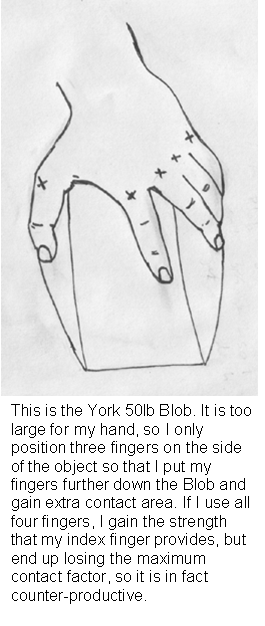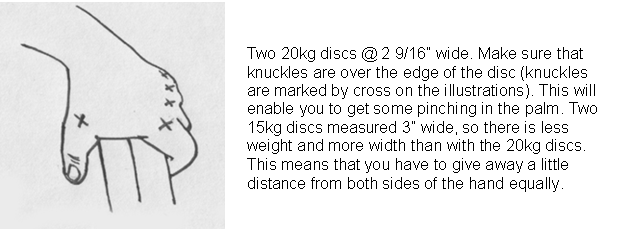
PINCH LIFT HAND POSITIONING
This way, that way, bull’s eye!By David Horne
This article was featured in Iron Grip magazine Vol 3 # 4, Oct 2003, and is now updated.
Sometimes one of the best ways to learn is to sit back and watch lifters of all abilities try the particular lift that you are working on. I’ve learned some great tips that way. But nowhere is this more obvious than in events requiring grip strength. Everyone uses their hands everyday, and so when they are confronted with a weight that looks movable, but of course is tough, they will use their knowledge of hand positioning and try to solve the problem and lift the weight.
One of the most simple and yet perplexing events is the pinch lift in all its many forms, and there are many. I wrote an article “How can I improve my pinch gripping ability?” which is in ‘Iron Grip’ Volume 2 Number 3. In it I illustrated the five basic types of pinching, and how to train to increase strength, especially in the ends of your fingers and thumbs. The homemade adjustable blob really did help, and we then started to work on the 50lb Blob, and of course Jim Wylie has now come to totally dominate this piece of apparatus. He can clean it, lift it with 2 fingers and also close a #3 CoC gripper in his right hand then pick the Blob up in his left hand. I have been lucky enough to see Jim do all this in front of me. I have also been able to now fully deadlift the 50lb Blob myself with the extra strength I have gained and the work on my hand positioning.
Many grip athletes will struggle on one piece of pinch apparatus over another. I know, I was one of them. Of course hand size is important, but for us individuals who are not blessed with large hands we just have to get on and try to address the problem. This is achieved by hand positioning, and it is SO important. Just grasping the object anyhow will not do anymore, especially in competition where the athletes are getting stronger and more clued-up by the day.
So what I want you to do is to start watching other attempts at the pinch apparatus that you are using, and then start playing with the hand position techniques that I am going to describe here.
Everyone has an optimum distance that is best for him or her. This is measured from the calloused part at the bottom of the index finger to the web at the base of the thumb. This distance when transferred to disc size will allow you to pinch in the palm of your hand as well as with your fingers and thumb. This is also discussed in the previous Iron Grip issue mentioned above. So for someone who has an optimum distance measurement of say 2”, the 2” width discs would be ideal, and of course 2 ½” would suffice for someone with a 2 ½” measurement, and so on. The difficulty can be when the feat of strength or contest event strays away from this, then we have to strengthen our weak points and improve our hand positioning. Of course more strength is always useful, but improved hand positioning can help to add pounds to your lift when your strength has not necessarily increased.
I will include diagrams of the varying hand positions that I have found useful on all sorts of widths and shapes. Of course these positions are always being tweaked to try to gain a better fastening. This is progress.
If the discs are wider than your optimum distance, then you may have to sacrifice some strength either on the fingers or thumb side. A millimetre one-way or the other can make a great difference. When someone has just conquered something like the Blob or two 20k discs together. They usually just have the strength to do this if everything is perfect, and this definitely means hand positioning. If their hand positioning is off ever so slightly next time then they will fail, just like you would with a big bench or squat. If an athlete’s strength is quite a bit above that particular feat then they will easily perform it even when their hand positioning is poor.
The diagrams below are all taken from my own hand, and so are all geared towards my own hand size (as are the comments). These will obviously need to be adjusted to suit the individual, but will give you some idea of how you can adjust your hand position to aid your own pinching. The pictures are of my left hand, drawn from the right hand side.
Of course, it is up to the individual to discover what position is best for him on each different type of pinch lifting. It way well take time, but the important thing is to recognise that this is a crucial part of any pinch lift, and if you can master it at the same time as bringing your strength up, you’ll hit the bull’s eye!
Copyright David Horne 2006


